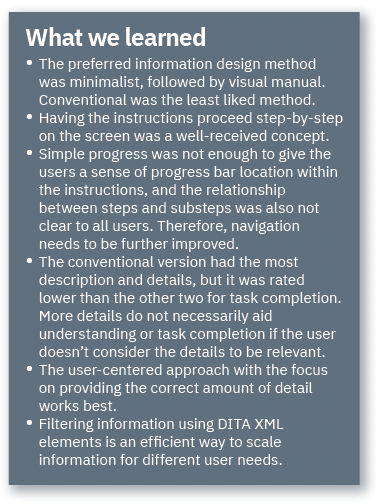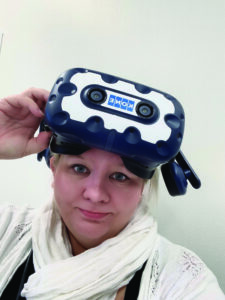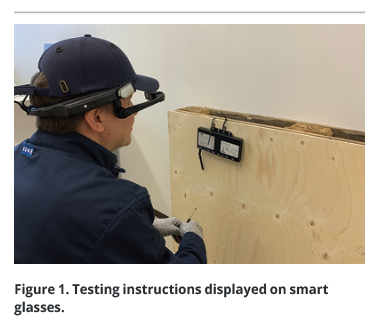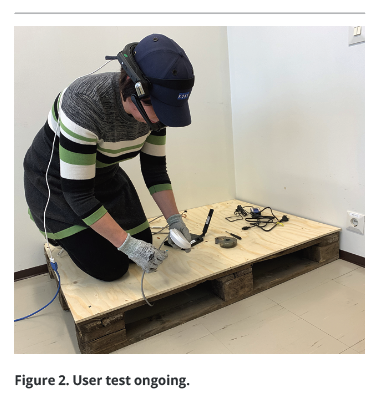You already have the skills to handle the transition to new media
Professional technical communicators know how to design, author, and publish technical instructions. We gather technical details, talk with subject matter experts, and organize the information. We create step lists, turn complex information into infographics, and make sure that terms are used consistently. When everything is ready and reviewed, we push the right buttons and create the needed outputs. Traditionally, instructions have been distributed as paper copies; more recently, they’re circulated as PDFs or through online portals.
But what happens when your company starts talking about new media? What is your answer when you hear buzzwords such as extended or virtual reality? The Internet of Things and connectivity? No need to worry — you have the skills to handle these already!
Exploring the Smart Glasses Scene
I started experimenting with using the Darwin Information Typing Architecture, an Extensible Markup Language (DITA XML), to create content for smart glasses some years ago. In the first experiments, I took existing technical instructions from the company content management systems and uploaded them to different devices. I invited colleagues from my company to test the devices and the instructions, and then to give feedback. The users had little or no previous experience with augmented reality and smart glasses, and the overall feedback was positive. Smart glasses were seen as a potential answer to a situation where the user’s hands are busy holding equipment parts and tools, so they cannot use their phone or hold a paper copy to read instructions.
Focus on Information Design
Based on these experiments, I concluded that DITA and the delivery part work nicely, but more focus needs to be put on designing the content so that it fits the users’ needs instead of automatically converting existing content. I then turned my focus to the user-centered design process, as it is one of the main principles of technical communication. In the next experiment, our research group created three versions of the same tasks: conventional (no redesign of the content, used as the baseline); visual manual (replacing text with illustrations, symbols, and icons); and minimalist (redesign based on minimalism heuristic). The content was created in DITA XML, and a simple application was developed for smart glasses to display the content. To minimize the need for scrolling, the application was designed to show one step at a time, progressing with voice-activated “next” and “back” buttons. We also used a filtering system that uses the semantic tagging of the content. This allowed us to show only certain parts of the existing content to the users, focusing on expert-level information. The setup was tested in a user test.
The Beauty of Single Sourcing and Reuse
I like to describe single sourcing as write once, reuse many times, and publish everywhere. In short, you can reuse the same piece of information to create instructions for several different products or user groups without having to copy and paste it. Furthermore, you can also use the same content to publish to several output channels: for example, HTML, the good old PDF, but also to XR solutions. With the approach I have been developing, you can use the same content you have been authoring for the traditional media, then publish a smart glasses-compatible version. There is no need to create separate content for XR — just use what you have! Naturally, as stated above, there are some things that need to be thought through if you want to deliver the content to smaller screens. However, I have noticed that the improvements we made, especially with the user-centered approach of minimalism, also improved the user experience when those instructions are viewed with a phone, read on the screen of a laptop, or even printed out as a traditional manual. Therefore, we were actually improving the overall usability of the content.
Content is Queen
 They say that the only thing that is constant is change. New devices are coming to the market, and the technologies advance rapidly. But what would these devices be without the content, the content that you are the expert with? As I see it, smart glasses are only a new media and delivery channel for us to get the information to the users. And you already have the skills to deliver content there!
They say that the only thing that is constant is change. New devices are coming to the market, and the technologies advance rapidly. But what would these devices be without the content, the content that you are the expert with? As I see it, smart glasses are only a new media and delivery channel for us to get the information to the users. And you already have the skills to deliver content there!
If you are already in XML, good! You can future-proof your content by making sure the tagging is semantically correct. If you are not yet in XML, there are many options of getting there, from open-source to commercial products. And as you have been doing, continue to think about the user — their tasks, goals, and information needs — and you are good to go!
Suggested Reading
- Heinonen, Hanna, Sanni Siltanen, and Petri Ahola. 2021. “Information Design for Small Screens: Toward Smart Glass Use in Guidance for Industrial Maintenance.” IEEE Transactions on Professional Communication 64(4): 407
–426. https://doi.org/10.1109/TPC.2021.3110616. - Siltanen, Sanni, and Hanna Heinonen. 2020. “Scalable and Responsive Information for Industrial Maintenance Work: Developing XR Support on Smart Glasses for Maintenance Technicians.” In Proceedings of the 23rd International Conference on Academic Mindtrek: AcademicMindtrek ’20, Tampere, Finland, January 29–30, 2020, 100–109. New York: Association for Computing Machinery. https://doi.org/10.1145/3377290.3377296

HANNA HEINONEN (hanna.heinonen@kone.com) is the digital content lead at KONE Corporation and a doctoral researcher at Tampere University. She has 20 years of experience in the field of technical communication as a writer, illustrator, information designer, and other related roles. Her specialties include information architecture and design; user-centered, task-based documentation; topic-based structured content creation (DITA XML); and content management systems and tools. She is pursuing a PhD in interactive technology at Tampere University, researching what XR can offer to technical communication. Contact her via LinkedIn: https://www.linkedin.com/in/hannaeheinonen.





